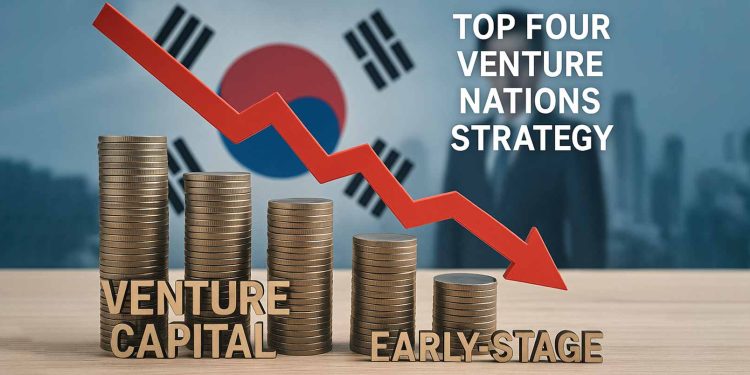Korea’s venture investment scene is entering a period of consolidation. As global economic headwinds persist, investors are focusing on verified mid-to-late-stage startups rather than early innovators. The government’s continued capital support is struggling to translate into on-the-ground liquidity, leading the ecosystem to watch closely for new policy intervention that could reignite early-stage growth.
Korean Venture Investment Slows, Concentration Deepens
Between January and October 2025, investment in unlisted startups and SMEs reached KRW 5.29 trillion (approx. USD 3.9 billion) — a 6.5% decline from the same period last year, according to data from The VC.
The total number of deals fell 34.2% year-on-year to 889, indicating sharper concentration of capital toward fewer, proven companies. October alone recorded 82 transactions worth KRW 497.6 billion, a noticeable drop from September’s strong momentum driven by several mega-rounds.
Despite the Korean government’s ongoing emphasis on expanding “adventurous capital,” market participants report that the impact has yet to be fully felt in the startup field.
Early-Stage Startup Funding Faces Sharp Contraction
Early-stage startups remain the hardest hit. Their share of total investment dropped from 38.3% in 2024 to 26.7% in 2025, while the number of early-round deals decreased from 82.2% to 72.9%.
A venture capital executive explained that persistent high interest rates and macroeconomic uncertainty continue to steer funds toward companies with established revenue streams. The executive said,
“Funds are flowing to mid- and late-stage startups that have proven business stability. Still, there is room for bold investments in deep-tech companies with defensible technologies, even if the round sizes are smaller.”
This selective trend reflects investors’ preference for risk-adjusted performance during prolonged global market caution.
Sector Shift Toward Semiconductors, AI, and Core Technologies
Investment data also show a notable move toward semiconductors, displays, and deep-tech sectors.
While deal count across these fields stayed relatively stable, their share of total funding volume increased from 9.2% to 13.6%, underlining Korea’s ongoing pivot toward technology-intensive industries such as AI, advanced materials, and manufacturing infrastructure.
Conversely, content and service-oriented startups — once major investment drivers in Korea’s creative economy — have faced relative contraction. The redirection signals how capital is now prioritizing industrial competitiveness and export potential rather than consumer-facing platforms.
Market Turns Attention to Government’s “Top Four Venture Nations” Strategy
October saw only 18 startups secure rounds exceeding KRW 10 billion (USD 7.3 million), led by U.S. biotech firm Pinetree Therapeutics, which raised USD 43.5 million (KRW 62.3 billion) in its Series A.
The slowdown has increased anticipation for the government’s forthcoming “Comprehensive Strategy for Becoming One of the World’s Top Four Venture Nations”, expected later this month.
Professor Lee Jung-hee of Chung-Ang University’s Department of Economics noted:
“Although the outlook is gradually improving, uncertainty still clouds the market. Investor sentiment will remain conservative until policy credibility strengthens. The question is whether the upcoming plan can genuinely restore confidence and trigger renewed venture activity.”
A Test of Policy Credibility and Market Adaptability
The present funding climate reveals both a disciplining phase and a strategic pivot for Korea’s startup ecosystem. Concentrated capital flows may improve efficiency and due diligence standards, yet they risk stifling the country’s early-stage innovation pipeline — a critical driver of long-term competitiveness.
That is why the case brings immense challenge to policymakers how to translate venture capital expansion into tangible early-stage liquidity. Meanwhile, founders and investors alike must also focus on leveraging Korea’s strengths in AI, semiconductors, and industrial deep tech to attract cross-border capital in Asia’s tightening funding environment.
Outlook for 2026 — Rebuilding Confidence Through Policy and Proof
Korea’s venture market now stands at a crossroads between consolidation and renewal. The forthcoming government strategy will serve as a barometer for policy execution and investor confidence heading into 2026.
If effective, it could balance selective investment behavior with a revitalized early-stage pipeline — ensuring that Korea’s ambition to become the world’s top four venture powerhouse is backed not just by capital, but by conviction.
– Stay Ahead in Korea’s Startup Scene –
Get real-time insights, funding updates, and policy shifts shaping Korea’s innovation ecosystem.
➡️ Follow KoreaTechDesk on LinkedIn, X (Twitter), Threads, Bluesky, Telegram, Facebook, and WhatsApp Channel.






